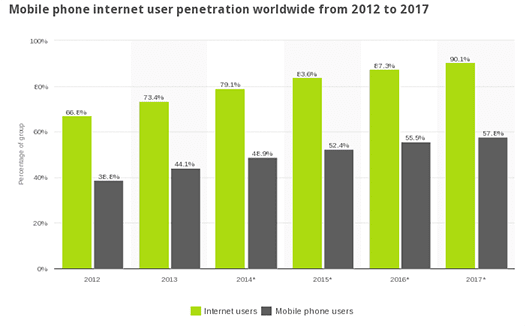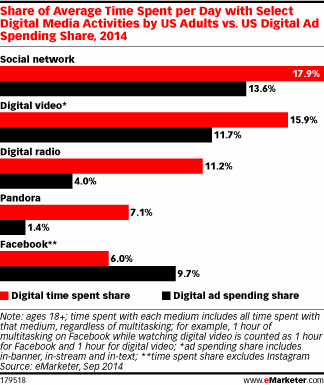
Alright, so it’s that time of the year again! With only about a month and a half left for us in 2014, obviously we need to start looking at the upcoming trends that will shape our marketing initiatives and functionally enhance business-in-general, in 2015. Over the next few days (if not already), you will constantly come across quite a few ‘marketing astrologers’ who will stargaze and tell you what the New Year holds for you and your business. We also receive many email requests from our clients and partners alike across the globe, asking us to write about what’s important about and how to tactfully approach “what’s next”. So, here’s our version of the 2015 digital marketing industry predictions and how you can already jump on the game plan (and thankfully, we don’t require stars or a crystal ball for this – no pun intended):
Multiple screens, ONE experience.
If the 2014 Super Bowl were any indication, the customers have already started a simultaneous consumption of data through multiple channels, screens and moments. A recent report from Statista suggests that the average global mobile Internet penetration in 2014 was about 79.1%, up by over seven percent y-o-y. It is expected to reach to over 90% in the next three years. Image concept courtesy: Statista.

And things are only about to get even more complex in 2015 with the continuous evolution in the wearable technology spectrum. May it be Google glass or iWatch or smart-ring, the number of screens as well as messages an average user is exposed to, is only sprouting with time. So if you’re a marketer, you need to find a way, in 2015, to provide a singular brand and product experience to your audience by effectively collaborating your efforts and overall communication, regardless of the screen they are exposed to and their respective stage in your marketing lifecycle.
Mobile-first SEO; Grown.
Many reports, throughout 2014, have been published, indicating the rapid growth in mobile web traffic as against its traditional counterpart and that it will completely surpass the desktop traffic by 2015. This fundamental shift in the web user behavior has brought major implications on global search engine optimization practices. In a blog post published earlier this year, Google suggests that 4 in 5 consumers carry out local searches and over eighty percent of them do it on their mobile devices. Hence, in the New Year, the businesses and marketers will have to rethink their existing ‘desktop-centric’ SEO tactics and re-divert the emphasis on real-time mobile search algorithms. So, in 2015, to keep up with the expeditiously expanding mobile SEO space, make sure that your website is mobile-ready and is accessible to any device. Start working on building a dedicated mobile SEO plan right away!
Fragmented searches; Longer keywords.
With the continuous introduction and evolution of different search platforms, mobile devices as well as applications, marketers cannot afford to rely on just the search engines on web browsers. On the other hand, as indicated by a Google fellow, nearly 20% of daily queries on the search engine are unique. Now, that’s some staggering figure. Also, instead of targeting one or two-word keywords or phrases, it might be more accurate and economical to focus optimization efforts on long-tail keywords. With the introduction of voice-enabled searches on mobile devices, strategically devised longer keywords will become more relevant and help catch the buying intent more accurately. So in 2015, prepare yourself and your brand to wield the power of long-tail keywords.
Fast, Flat and Furious Websites.
In 2014, we have seen the decline of the website as we know it. The users, today, don’t necessarily have to rely on just the website (and on just one screen) to gain information about your business and offerings. Content is no more bound by a set frame of design. While this concept might be gaining popularity, websites still play a vital role in determining the online success of any business. What’s changed is how people use your website. Another important study by Google confirms that about 7 in 10 consumers get frustrated and heart-broken, if a site doesn’t load properly on their mobile devices. Your customers, in 2015, will not want to read up longer keyword-rich paragraphs on your site. What they would fancy instead is viewing a compelling story. Rather than being bombarded by large amount of heavier text, they prefer seeing crispier, flatter and easy-on-the-eyes visuals. Websites that have richer backgrounds and minimal (or what we call as ghost) navigation, will create a focal point for effective and persuasive calls-to-action. Another essential element to be implemented is – understanding how one-page scrolling can benefit your user’s experience rather than having to rely on poorly structured and implemented navigation menus.
Social Media – The free lunch is over.
The biggest challenge facing the social media marketers in 2015 is the continually splitting social audience. Gone are the days when you could conveniently rely on Facebook, Twitter, LinkedIn and Google+ to engage with your customers. The rate at which newer and more innovative social media platforms are being introduced, it poses some serious demand for the brand marketers. Finding the right places to catch the right audience at the right time through the right brand voice is getting increasingly complex. Another important aspect is that social is no more a free-space for those who want prominent results out of it. With organic reach getting squeezed down to roughly 0.07 percent on Facebook (Izideo) as well as other major social media channels, in 2015, you need to draft a smarter social advertising strategy. If we were to believe a study by eMarketer of the U.S. adult digital audience as against the average digital ad spend share, most of the social platforms have started emphasizing heavily on paid reach. Image concept courtesy: eMarketer.

So, instead of just keeping on posting random content across the social platforms hoping that it will click sooner or later, you should take the time in digging deeper on audience segmentation and competition targeting. Thoroughly understand the advertising model and ad products offered by different social media channels in order to hit the right voice to the right audience.
The evolved phase of online reputation management.
2014 saw businesses and marketers expand their focus on developing independent and sophisticated plans surrounding their online reputation in the ever-evolving digital ecosystem where consumers are largely influenced by online reviews. An online consumer review survey conducted earlier this year suggests that about 8 in 10 consumers actively look for and believe in reviews by other customers on the Web, as if they were recommendations from their friends and family. Image concept courtesy: BrightLocal.

In 2015, these online brand reputation monitoring and management efforts will only get more streamlines with the rapid expansion of big data. Managing a brand’s reputation on the web will no longer be just a job of corporate communications. This responsibility will be shared by all wings of business, media relations, market research, finance, support, etc. – resulting in quantification of a brand’s online image. Social relevance will play a vital role in determining how high or low a business ranks in managing reputation. So, work on proactively changing the perception about your brand in 2015 instead of looking for ways to manage the reviews.
People-focused paid digital advertising.
If 2014 was about ad campaign automation and mobile growth, the New Year will see the rise of audience-based ad campaigns – a movement toward user behavior predictability. With Facebook Atlas already in the game, 2015 will only get bigger and better for the paid advertisers. The marketers will no longer need to shoot the arrow in dark, because they will be able to identify exactly who is seeing their ads, and on what device, etc. Based on the buyer intent, the ad campaigns will be created with optimized re-targeting. This will help in delivering relevant marketing message to the right set of audience at the right place and in the right time. Again, mobile will continue to play a major role in search engine marketing in 2015 with about half the digital ad spend predicted to be consumed by mobile. As per a recent mobile search ad report, nearly eight percent of consumers who view an ad (with a phone number) on mobile are more likely to click on it. Having mentioned that, the emphasis in 2015 will come back on creativity and innovation of the campaign in order to improve the overall conversion across channels, devices and audiences alike.
These are some of on what has 2015 in store for the global online marketing fraternity. These tips will not only help improve your awareness but they will also help you understand the factors you need to consider while chooing the right digital marketing agency.



